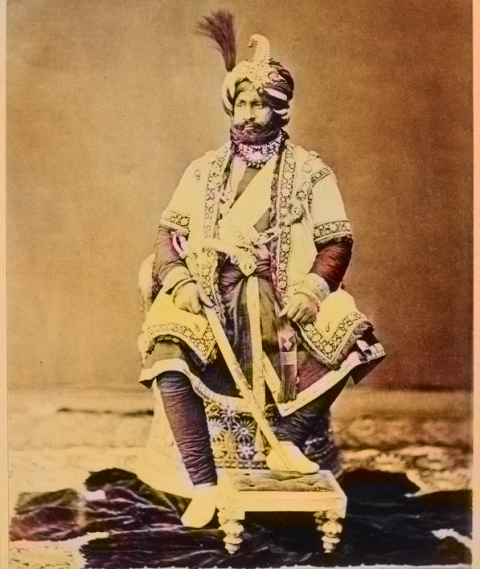Today, on occasion of his death anniversary, the state remembers Maharaja Ranbir Singh, a visionary leader, a warrior, a humanitarian and a scholar. In his lifetime, the Maharaja achieved various feats and initiated various reforms; one of which is the lifeline of Jammu— the Ranbir Canal.
Before the construction of Ranbir Canal (before 1903 AD), irrigation facilities in plain areas of Jammu were very limited.
Pratap Canal, which irrigated agricultural land lying towards west of Chenab river, was started in 1900 A.D as a famine relief work and completed in 1905. The project cost Rs. 5,10,000.
Despite the latest canal, most farmlands towards east of Chenab river (i.e. in Jammu, Samba & RS Pura tehsils) still lacked dependable and regular irrigation facility.
For cultivators near Jammu city, there existed those days a water channel namely Jogi Gate Canal which was tapped from river Tawi. It was actually a small minor about 5.5 miles in length with a mean discharge of about 10 cusecs.
In RS Pura and Samba tehsils where lands were plain (thus better suited for agriculture) and the farmers there depended only on rains and few wells. Thus necessity of a canal from river Chenab to irrigate agricultural lands in Jammu, RS Pura and Samba Tehsil was long felt.
In around 1873, during the Maharaja’s rule, a canal called Shahi Canal was started from Akhnoor village on the left bank of Chenab. It was excavated uptoBhagiar Khad (about midway between Jammu and Akhnoor). The project proved to be a failure.
Another project, called the Rajpura Canal too failed. It had been dug up to Hazoori Bagh, the Maharaja’s garden in Jammu. The canal had the same leveling issues as witnessed in the Shahi Canal.
Despite consequent failures, the Maharaja didn’t give up, and in 1903, construction of another canal for taking water from the Chenab for irrigation was stipulated.
Since the vision and efforts for this canal were visualised during Maharaja Ranbir Singh’s rule, the State Council in its resolution No. 41 dated 5-11-1903 named this canal as Ranbir Canal.
To carry forward the work more efficiently, Rai Sahib Makkan Lal was installed as Div. Engineer at a high monthly salary of Rs. 600. (Unlike at present the salary and status of engineers those days was much higher than other public servants).
The canal was designed as a gravity-run water channel (with no pumping involved anywhere) for a total discharge of 720 cusecs of water.
The canal traversed up to Jammu city, crossed Tawi river through an underground masonry super-passage and then running through plains of RS Pura & Samba tehsils, terminated at the State boundary with the then British-ruled Punjab in village Dohali in R S Pura tehsil.
Total designed length of Ranbir Canal is 59.55 Kms (26.55 Kms from Akhnoor to Jammu and 33 Kms from Tawi river in Jammu city to its terminal point in R S Pura tehsil).
A network of roads was also constructed all along the distributaries/main Canal. For regulation of water supply, a telegraph line all along its length was laid for prompt transfer of site information to H/Q in Jammu.
Ranbir Canal was also made navigable from Akhnoor to Jammu and small boats used to ply in it for the recreation of the elite.
The project, cost Rs. 36.50 lakhs and took about nine years to complete.
Changes brought by the Canal:
Ranbir Canal was thus truly the first game-changing project which laid the foundation for rapid transformation of not only rural economy of vast agricultural belt in its catchment area but it changed the face of Jammu city as well.
- Cultivators who were previously sowing millet and chari (low crops) switched to better crops like rice and sugarcane.
- The famous basmati rice of R.S. Pura owes its cultivation primarily to Ranbir Canal.
- Besides fruits/vegetable cultivation in its catchment area got a fillip and their imports from adjoining Punjab State got reduced drastically.
- Ranbir Canal system opened up 274 kms of good cart roads (constructed along all 17 no. distributaries) thus encouraging mobility of people and goods in its catchment area. It contributed in a big way in ushering in faster economic growth in the region.
- Hydroelectric generation from Ranbir Canal in Jammu city replaced expensive steam power, which was earlier used to lift water from river Tawi, for the residents of then Jammu city located on higher plateau. It also improved electric supply system in the city and gave strong push to the growth of agro-based small scale industries in and around Jammu city.
- Ranbir Canal carrying ice-cold glacier water, running through Jammu city, increased the beauty and magnificence of Jammu city. It is now a very special heritage asset of Jammu region.Read also: 8 Things You Didn’t Know About Radio Kashmir Jammu – That Completes 70 Years
Sadly, Jammu has lost such visionary leaders, and has lost a will to preserve its heritage. Unorganised urbanisation and dumping of waste by the locals has reduced this cool stream of water into a nallah at places. Let us not lose, whatever little has left of, our Dogra heritage to selfish acts and greed.


